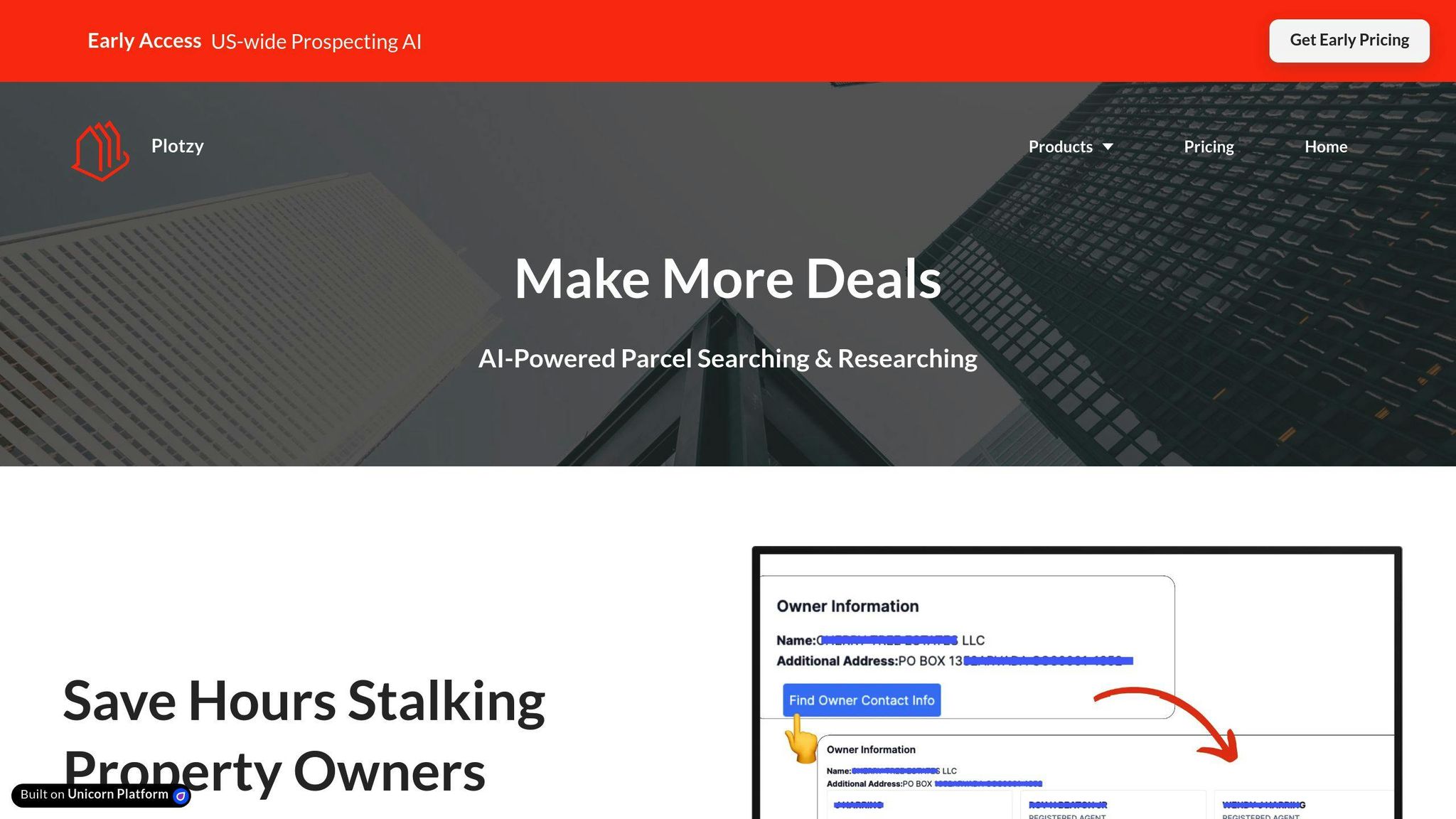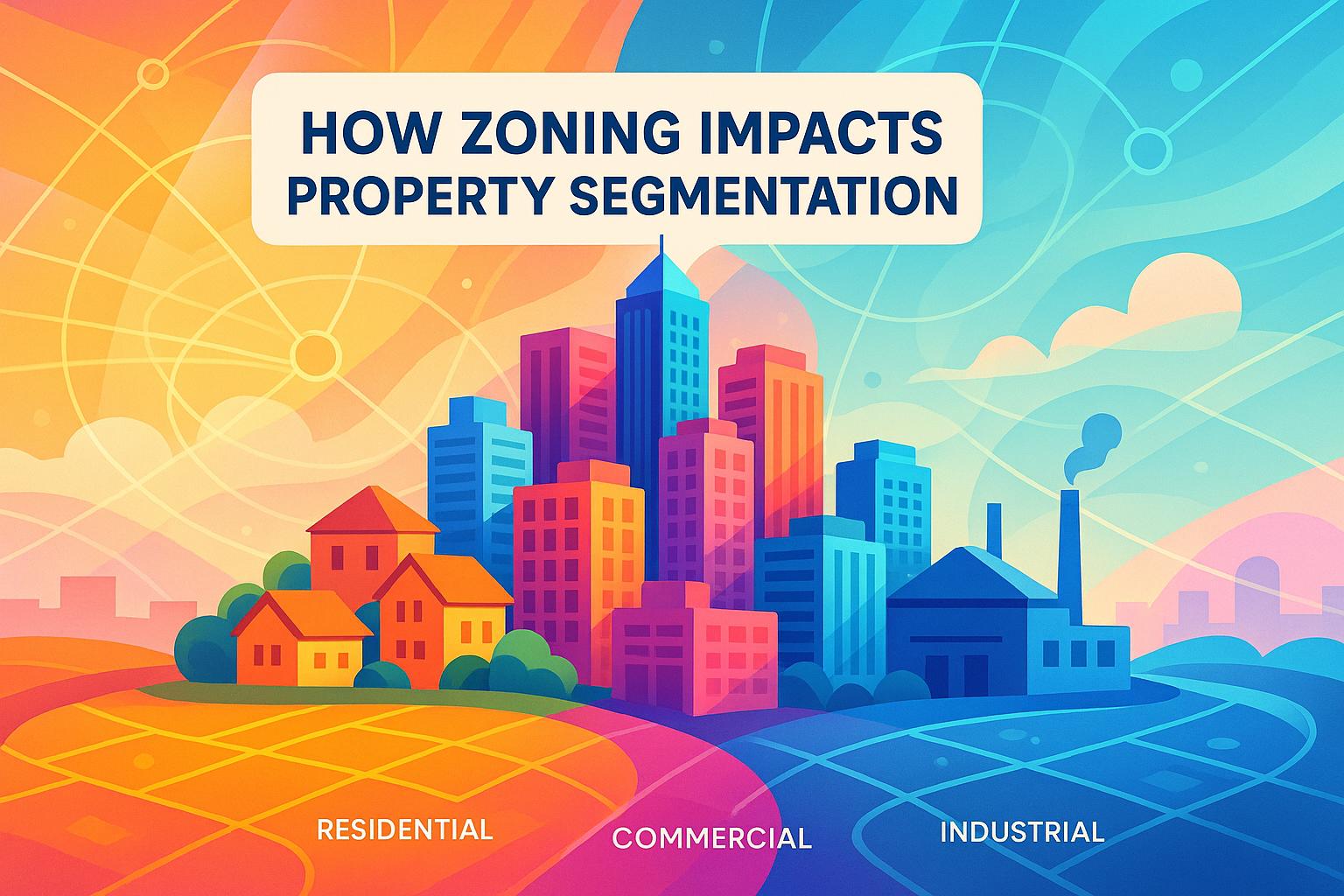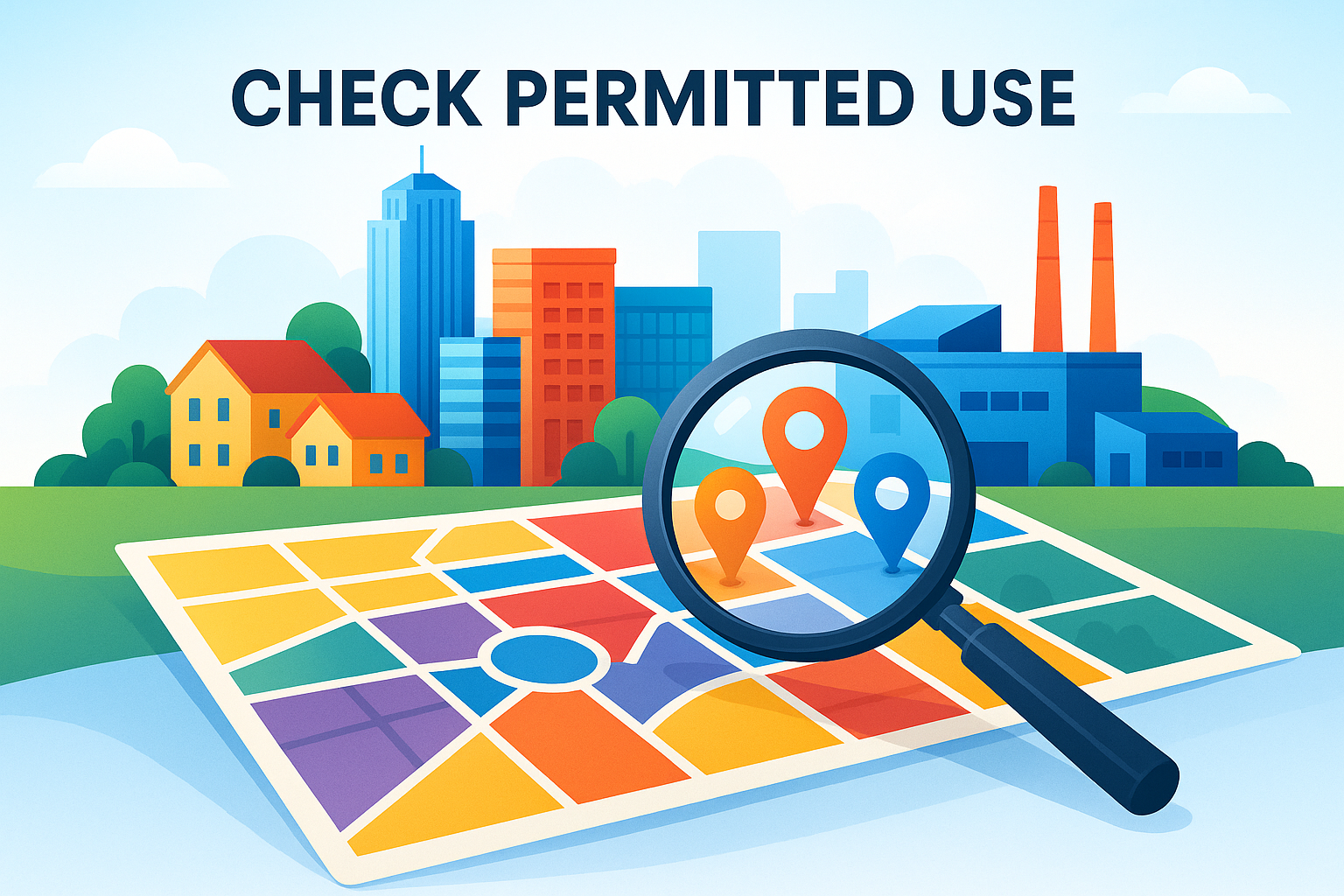Owning commercial property means managing real estate used for business purposes, like offices, shops, or warehouses. It offers income through rent, tax benefits, and potential property value growth. However, it comes with responsibilities like maintenance, tenant management, and regulatory compliance.
Key Points:
- Benefits: Steady rental income, tax deductions, and investment diversification.
- Challenges: High maintenance costs, zoning restrictions, and tenant disputes.
- Ownership Models: Options include sole ownership, LLCs, partnerships, and REITs, each with unique tax and liability implications.
- Technology Tools: Platforms like Plotzy simplify compliance, zoning checks, and property research using AI.
Managing commercial property requires balancing risks, staying updated on market trends, and leveraging tools like AI for smarter decision-making. Let’s explore how to navigate these complexities effectively.
4 Ways to Use AI in Commercial Real Estate
Responsibilities and Challenges of Owning Commercial Property
Owning commercial property isn’t just about investing money - it’s about active management, balancing responsibilities, and tackling challenges head-on.
Key Duties of Commercial Property Owners
Commercial property ownership comes with a set of responsibilities that influence both the property's value and tenant satisfaction. Owners need to ensure their buildings remain structurally sound, which includes maintaining foundations, roofs, exterior walls, and essential systems. Common areas like lobbies, elevators, and parking lots also require regular upkeep to keep them in good condition.
Another important duty is staying compliant with local regulations. This means ensuring tenant activities align with zoning laws and maintaining proper documentation of compliance efforts.
Insurance is also a must. Property owners typically need coverage for physical damage (property insurance), accidents or injuries (general liability insurance), and financial protection during disruptions (loss of income insurance).
Challenges in Commercial Property Ownership
One of the biggest hurdles is managing the costs of utilities, repairs, and maintenance, which can directly impact profitability. Zoning restrictions can also limit how a property is used or developed, creating additional complications. On top of that, tenant disputes - whether over lease terms or other issues - can be time-consuming and stressful to resolve.
Balancing Risks and Rewards
Keeping up with inspections and maintenance is essential for meeting a property owner’s duty of care. Technology has become a valuable ally in this area. Platforms like Plotzy, which use AI, can simplify property research, zoning checks, and due diligence, reducing the chances of errors or compliance problems.
To boost returns while staying compliant and maintaining safety, property owners should:
- Carefully screen potential tenants
- Communicate clearly and keep detailed records of property-related activities
- Stay informed about market trends and regulatory changes
- Prioritize preventative maintenance to avoid costly repairs later
Working with legal and real estate professionals can help owners foresee potential issues and make smarter decisions. By combining these strategies with modern tools, managing commercial property becomes more efficient and less risky.
Using Tools and Technology for Property Research
AI-driven platforms have simplified property ownership tasks, cutting down on the time and effort needed to handle complex processes.
How Plotzy Supports Property Research

With Plotzy's $200/month Standard plan, users gain access to features like AI-powered parcel searches, owner contact details, zoning analysis, permitted use filters, and custom filtering options. These tools provide detailed property insights, helping owners make informed decisions in today's challenging market.
AI Tools for Zoning and Compliance
AI tools play a key role in keeping property owners informed about zoning updates and regulatory changes. Plotzy is built to address zoning compliance issues with ease. Its system uses up-to-date databases covering land use classifications, zoning codes, and regulations, allowing property owners to:
- Check if properties comply with local rules
- Stay updated on zoning changes
- Access detailed zoning reports for better decisions
- Identify permitted uses for specific parcels
Enhancing Due Diligence with Technology
Technology has reshaped the due diligence process by offering data-rich insights and automated analysis tools. Property owners can now review comprehensive reports featuring property details, market trends, and possible risks.
AI tools make due diligence more efficient by consolidating property data, providing analytics for better decisions, and minimizing risks with automated compliance checks. These advancements help property owners confidently manage ownership complexities and legal obligations.
sbb-itb-11d231f
Ownership Structures and Legal Requirements
Types of Ownership Models
Ownership structures play a key role in how liability, taxes, and control are managed. Each model offers different options for property owners, depending on their goals and needs.
| Ownership Type | Key Features | Tax Approach | Liability Coverage |
|---|---|---|---|
| Sole Ownership | Full control, straightforward setup | Pass-through taxation | No liability protection |
| LLC | Flexible management, easier transfer | Multiple tax options | Strong liability protection |
| Partnership | Shared resources and expertise | Pass-through taxation | Limited liability protection |
| REIT | Professional management, high liquidity | Corporate tax + dividends | Full separation of liability |
Legal Rules for Property Owners
Property owners must navigate building codes and zoning laws to remain compliant. Regular inspections can help catch potential issues early. Tools like Plotzy use AI to streamline compliance by automating zoning checks and organizing lease documents.
Key compliance areas include:
- Ensuring structural and safety systems meet local standards
- Securing permits for renovations and meeting related requirements
- Adhering to accessibility standards for tenants and visitors
Understanding Lease Agreements
Lease agreements are essential for defining the relationship between property owners and tenants. A well-drafted lease can reduce disputes and protect everyone involved.
Important elements in commercial lease agreements include:
- Lease Duration and Terms: Clearly state start/end dates and renewal options.
- Financial Obligations: Specify base rent, annual adjustments, and shared costs like common area maintenance (CAM).
- Maintenance Responsibilities: Tenants typically handle day-to-day tasks, while landlords manage structural systems like the foundation and exterior.
- Insurance Requirements: Outline minimum coverage levels for both the tenant and landlord.
Be clear about how CAM charges are calculated to ensure transparency and avoid misunderstandings with tenants.
Understanding these ownership models and legal frameworks sets the stage for navigating the evolving commercial real estate landscape.
Trends and the Future of Commercial Real Estate
Current Market Trends
The shift to hybrid work models is changing the demand for office spaces. Traditional office setups are seeing less interest, while flexible workspaces are gaining popularity. Mixed-use developments, which combine residential, retail, and office spaces, are increasingly favored for their ability to create dynamic communities. At the same time, property owners are focusing on energy-efficient systems and sustainable designs to meet environmental standards and cut costs.
In this evolving landscape, AI is becoming a key tool to help property owners navigate these changes effectively.
AI's Role in Commercial Real Estate
AI is reshaping property management and investment evaluation by addressing common challenges in the industry.
| AI Application | Impact on Property Ownership | Business Benefit |
|---|---|---|
| Valuation Analysis | Processes real-time market data | Delivers more precise valuations |
| Predictive Maintenance | Identifies issues early | Lowers maintenance expenses |
| Market Intelligence | Tracks market trends | Supports smarter investments |
| Tenant Management | Automates tenant support services | Increases tenant satisfaction |
These AI-driven tools streamline operations, from predictive maintenance and market intelligence to tenant services. They also complement zoning and compliance tools, making property management more efficient.
Preparing for Changes in the Market
To remain competitive, property owners need to embrace AI tools, prioritize sustainable technologies, and create spaces that can adapt to shifting tenant needs. According to research by JLL, 75% of commercial real estate investors expect AI to have a major impact on the industry within the next five years.
Key strategies to adapt:
- Technology Integration: Use advanced tools for property management and analysis.
- Sustainability Initiatives: Focus on green building technologies and energy efficiency.
- Flexible Space Design: Create spaces that can adjust to evolving tenant demands.
Platforms like Plotzy can provide valuable market insights, helping property owners make informed decisions about upgrades and investments. Regularly assessing market conditions is essential for staying ahead in this ever-changing industry.
Summary and Next Steps
Key Takeaways
Owning commercial property comes with a mix of responsibilities and the need to keep up with shifting market trends. Owners must juggle tasks like maintenance, tenant needs, and compliance while staying aware of market changes. Throughout this guide, we've highlighted how integrating AI tools and staying ahead of the curve can help manage these challenges.
Technology has reshaped property management. AI-driven tools now streamline tasks like compliance checks, offer real-time market insights, and simplify decision-making. These advancements not only save time but also help reduce risks and improve outcomes for property owners.
Action Plan for Property Owners
For success in today’s commercial real estate market, property owners should blend traditional expertise with modern technology.
Important Steps to Consider:
- Perform regular property inspections, ensure insurance is up to date, and use AI tools to streamline compliance and research.
- Leverage AI-powered platforms for market analysis and efficient property management.
- Incorporate eco-friendly technologies and design flexible spaces to meet changing tenant expectations.
With hybrid work models influencing tenant needs, creating flexible spaces is crucial for staying competitive. Owners who embrace technology and adapt to market demands are better positioned to grow and succeed in the commercial real estate landscape.
AI tools like Plotzy make tasks like compliance and market research easier, giving owners a way to save time and reduce risks. Combining these tools with solid property management practices can help owners overcome market challenges and maximize their investments.


